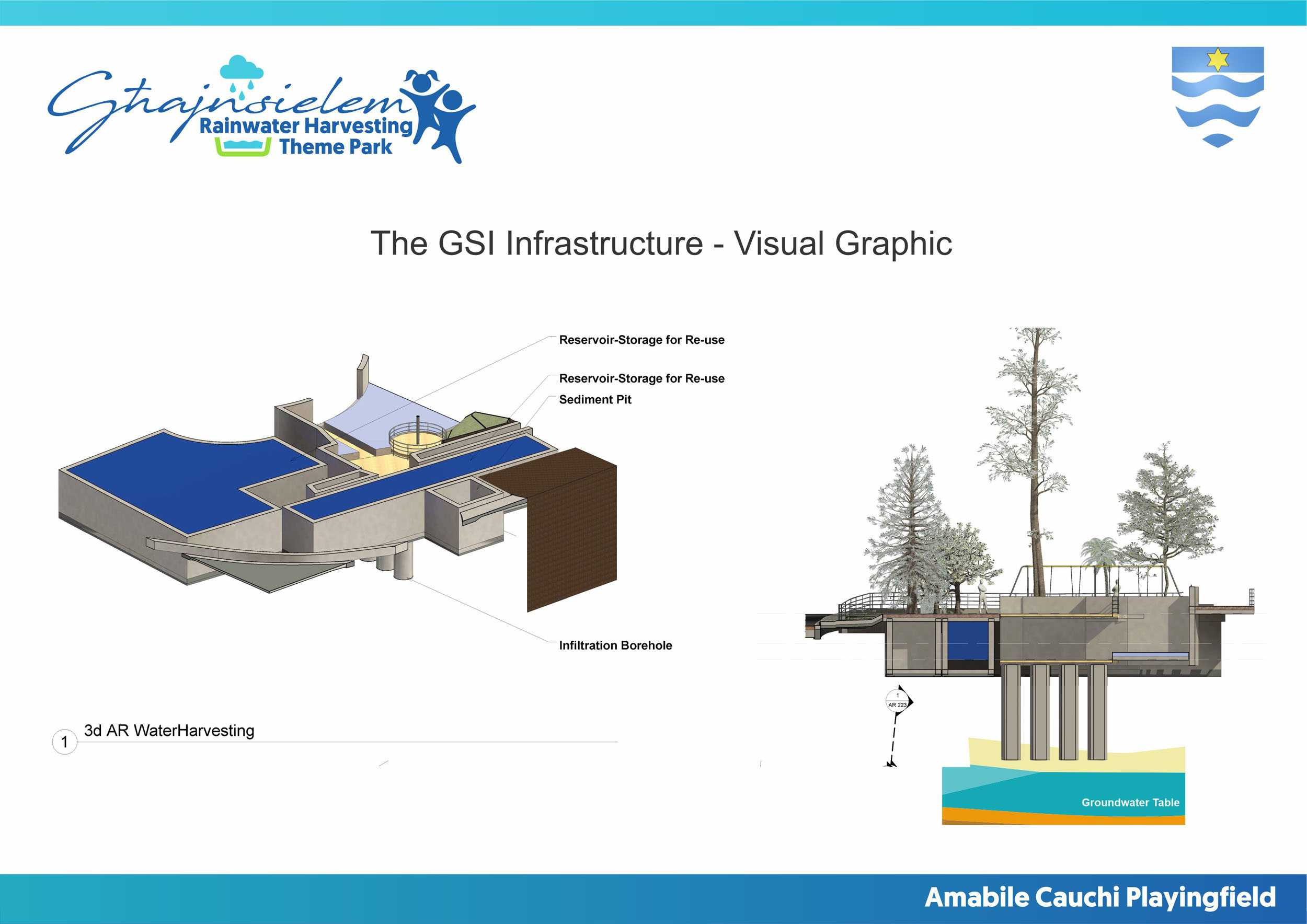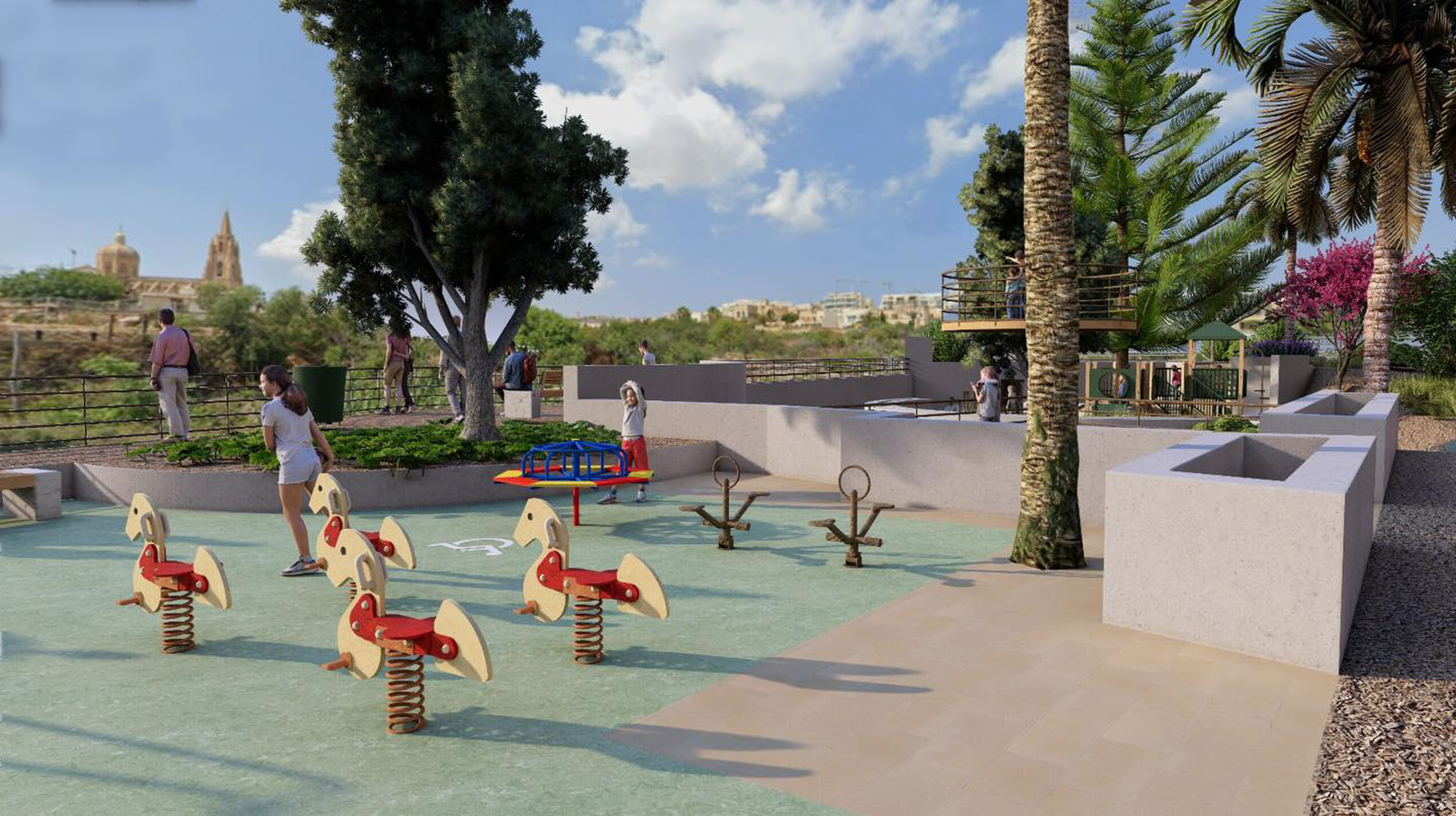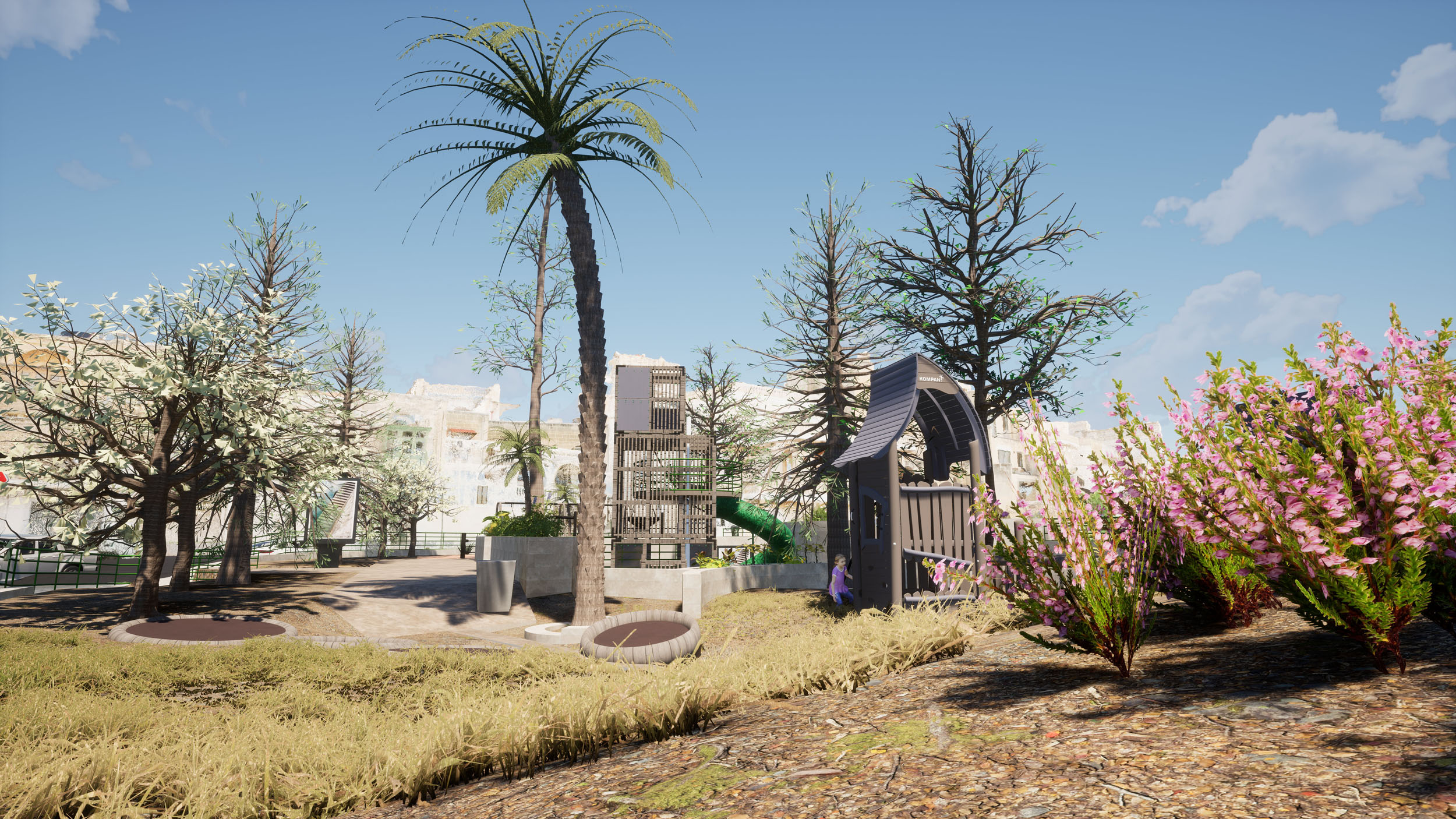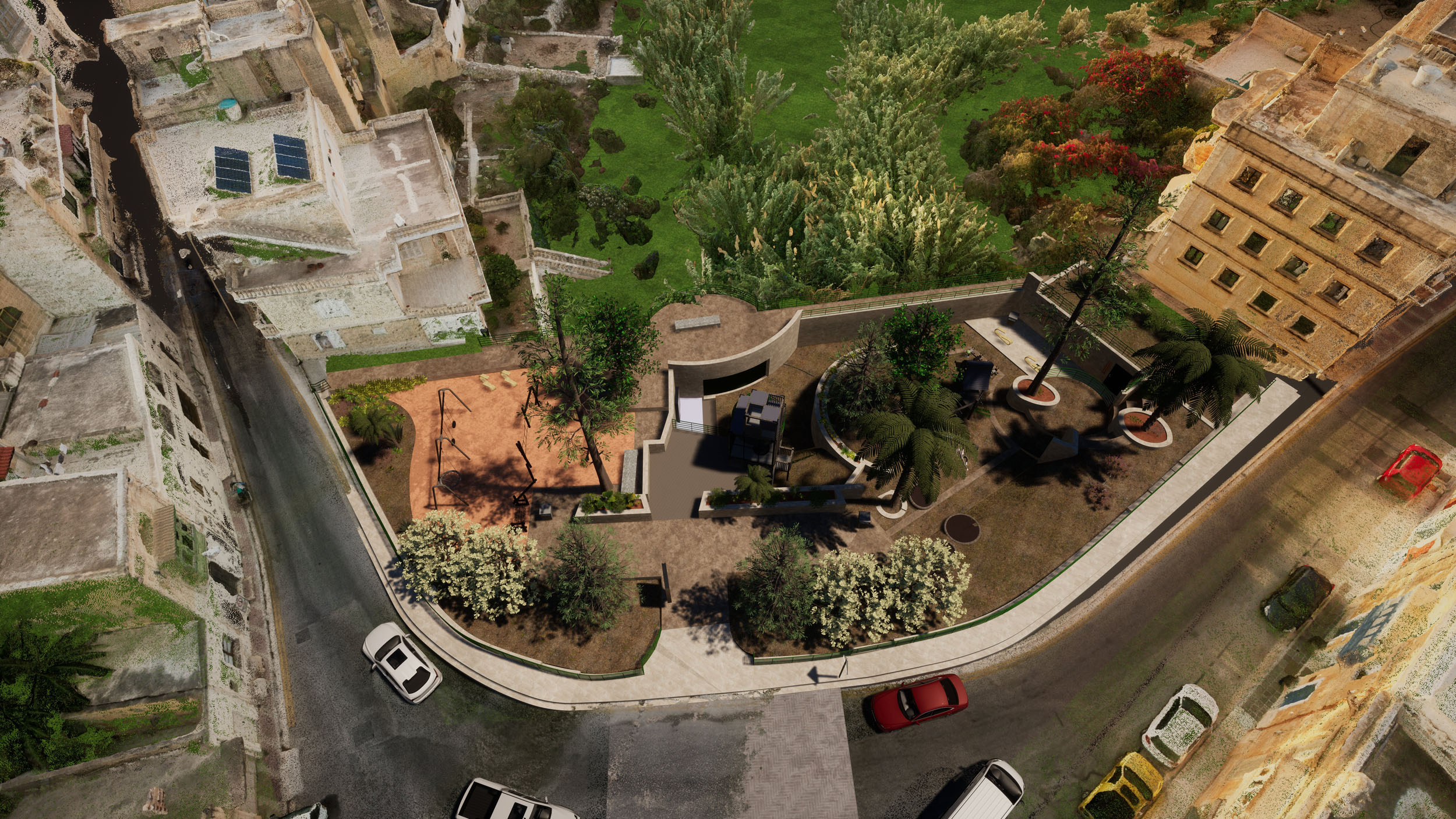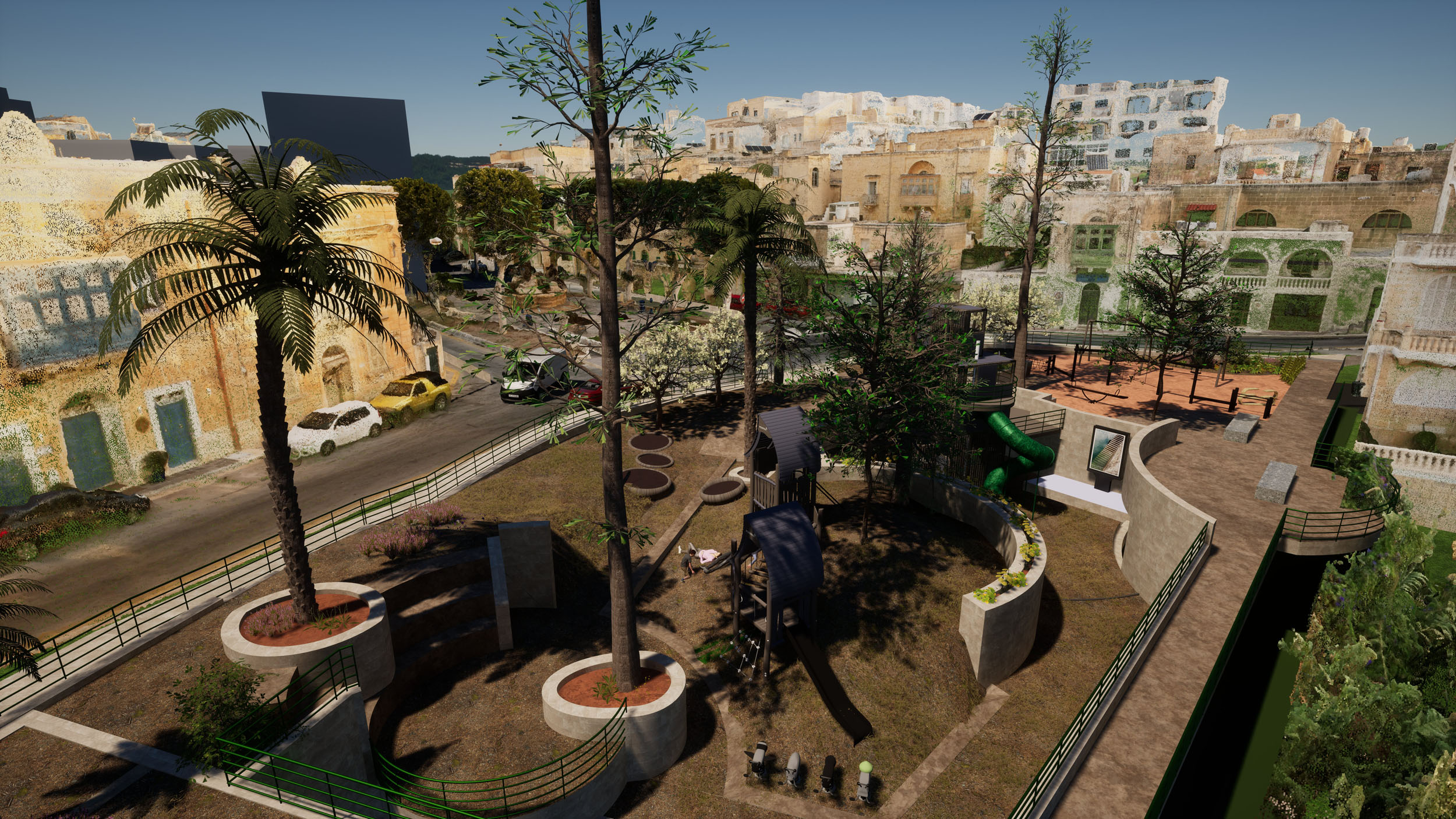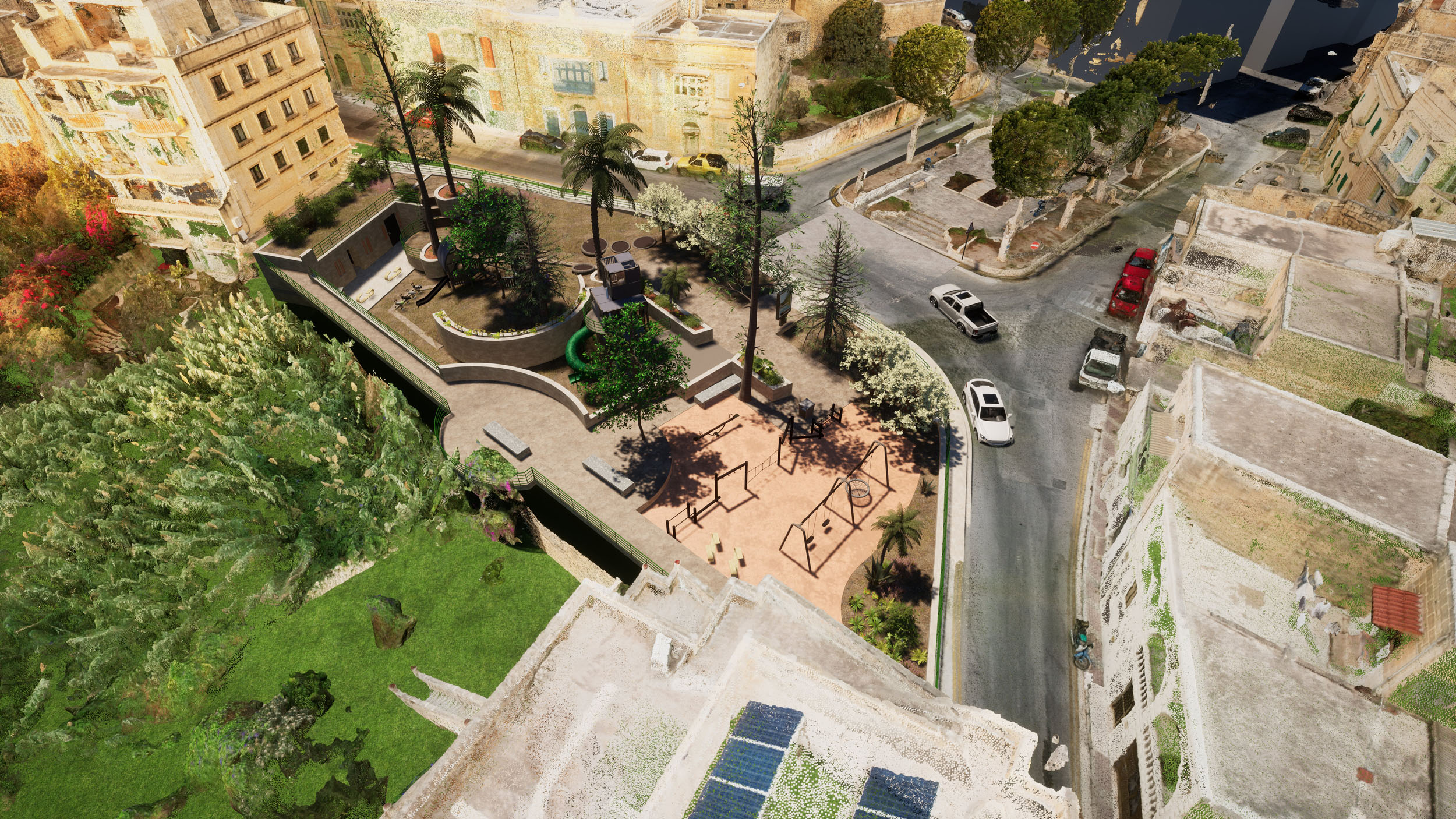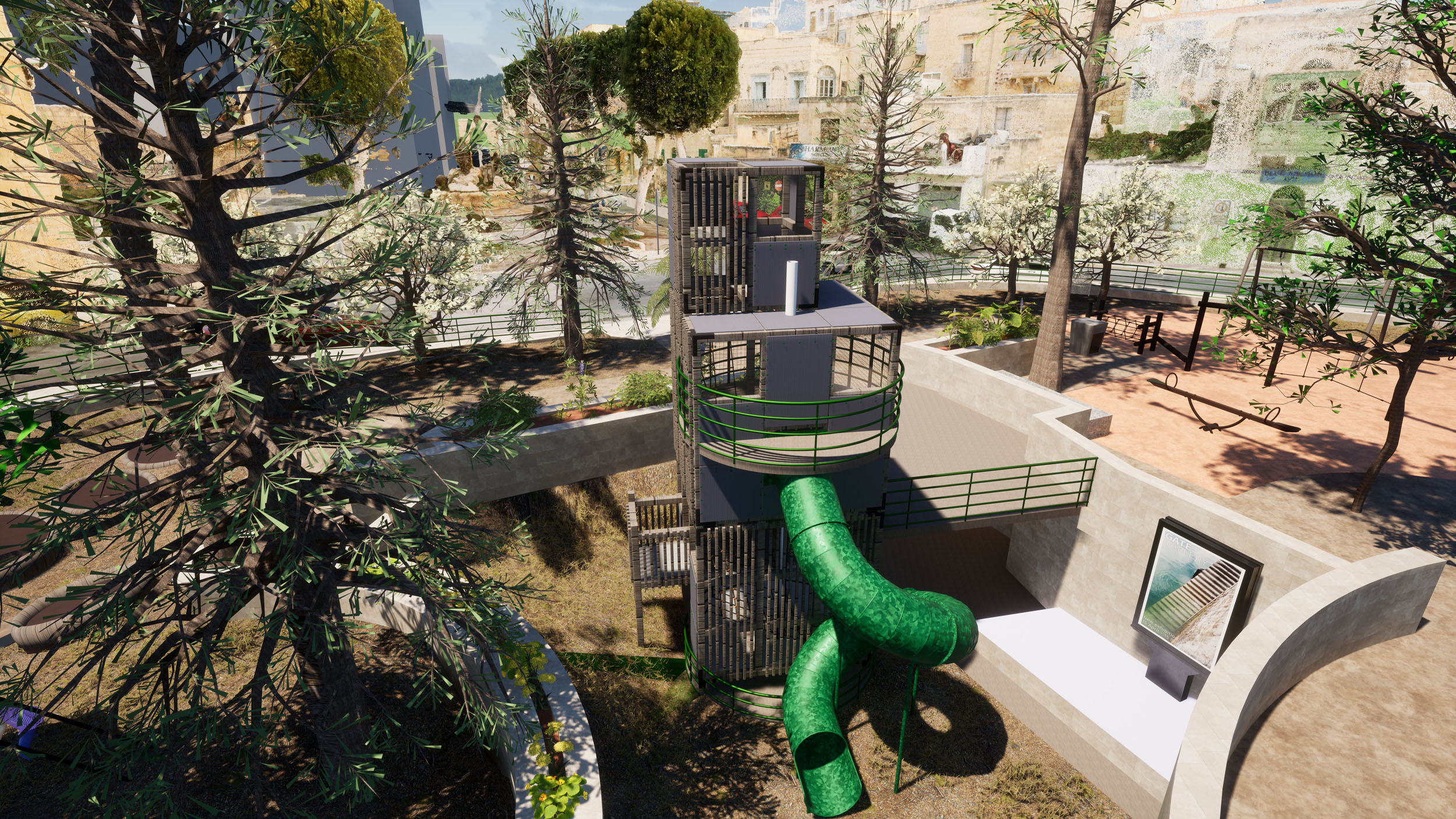Ghajnsielem Rainwater Harvesting Park
Turning open space into Green Stormwater Infrastructure (GSI) Rainwater Harvesting Play Park
This project reimagines a traditional open space and integrates sustainable green stormwater infrastructure (GSI) solutions to offer effective rain water management. Considering that Malta is a densely populated and water-stressed country with limited freshwater resources, this project aims to be a showcase model on how public projects can capture and use rain water. Benefits include groundwater recharge, reducing the risk of flooding and erosion and building resilience for climate change.
Malta
Amabile Cauchi Playingfiled
Pjazza tad-Dehra
Għajnsielem
Gozo
Malta
Pjazza tad-Dehra
Għajnsielem
Gozo
Malta
Early initiative
Yes
Yes
Yes
Yes
EU LIFE Integrated Project (LIFE IP) RBMP Project (2018-2025)
No
MT02622: Għajnsielem and Comino (MT)
How we manage water within our spaces has a huge impact on the quality of our environment and lives. Good management of rainfall can make the places in which we live more attractive and resilient to climate change. Considering that Malta is a densely populated country with limited freshwater resources, it is of utmost important that the scarce rainfall is not lost at sea. A recent study showed that 16% or more of groundwater volume is expected to be lost over the next 80 years due to climate change.
Therefore it is of utmost importance that new projects take in consideration the preservation of water through the integration of green stormwater infrastructure (GSI). Unfortunately, this is lacking in the majority of all new public initiatives.
Despite size and limited resources, Għajnsielem Council is committed to setting an example with an ambitious initiative. By tapping from EU and central government funds, a derelict playing area will be transformed into a sustainable, multifunctional recreational space with significant stormwater harvesting. Being built on a valley pathway, this playingfield was prone to flooding. A 2022 hydrological study revealed 84,000 cubic meters of stormwater is generated annually in the area, mostly lost at sea. The project aims recover considerable volumes of fresh water through groundwater recharge, addressing Malta's groundwater deficit. It will also mitigate flooding and downstream soil erosion.
Over 1140sqm of upgraded open space will include educational areas, a communal garden, and increased greenery. Work is slated to begin later this year. The space will feature an amphitheater, new play equipment, a community garden, public conveniences, and accessibility features. Families, children, and the elderly will benefit. The project aims to address local water challenges, enhance climate change resilience, and create a more beautiful, sustainable and liveable community.
Therefore it is of utmost importance that new projects take in consideration the preservation of water through the integration of green stormwater infrastructure (GSI). Unfortunately, this is lacking in the majority of all new public initiatives.
Despite size and limited resources, Għajnsielem Council is committed to setting an example with an ambitious initiative. By tapping from EU and central government funds, a derelict playing area will be transformed into a sustainable, multifunctional recreational space with significant stormwater harvesting. Being built on a valley pathway, this playingfield was prone to flooding. A 2022 hydrological study revealed 84,000 cubic meters of stormwater is generated annually in the area, mostly lost at sea. The project aims recover considerable volumes of fresh water through groundwater recharge, addressing Malta's groundwater deficit. It will also mitigate flooding and downstream soil erosion.
Over 1140sqm of upgraded open space will include educational areas, a communal garden, and increased greenery. Work is slated to begin later this year. The space will feature an amphitheater, new play equipment, a community garden, public conveniences, and accessibility features. Families, children, and the elderly will benefit. The project aims to address local water challenges, enhance climate change resilience, and create a more beautiful, sustainable and liveable community.
Sustainability
Climate change resilience
Groundwater recharge
Green stormwater infrastructure
Water management
The Għajnsielem Rainwater Harvesting Theme Park project aligns with sustainability principles in several key ways:
1. Efficient Water Management:
• Stormwater Collection and Storage: The project includes Green Stormwater Infrastructure (GSI) systems to collect, settle, and store stormwater. This water is then used for landscaping and irrigation, reducing the need for external water sources.
• Aquifer Recharge: Surplus stormwater is directed to recharge the underlying aquifer, helping to maintain groundwater levels and reduce the risk of flooding.
2. Environmental Preservation:
• The project involves maintaining natural areas, such as the valley side and historical structures, to enhance their ecological value.
3. Community Engagement and Education:
• Multifunctional Recreational Space: The transformation of the Amabile Cauchi playing field into a multifunctional space includes features like an amphitheater, community garden, and educational hub, promoting community engagement and environmental awareness.
• Educational Programs: The project includes educational programs and interactive areas to teach children and residents about water conservation and the importance of sustainable practices.
4. Sustainable Infrastructure:
• Permeable Paving and Filtration Systems: The use of permeable paving and filtration systems ensures proper stormwater management and reduces surface runoff.
• Energy-Efficient Lighting: The project includes low-light pollution standards for new illumination, contributing to energy efficiency.
5. Flood Mitigation and Soil Conservation:
• Flood Reduction Measures: The project implements measures to reduce flooding, soil erosion, and damage to cultural structures and neighboring properties.
• Improved Access for Maintenance: Enhanced access to the valley facilitates maintenance and emergency response, ensuring the long-term sustainability of the area.
1. Efficient Water Management:
• Stormwater Collection and Storage: The project includes Green Stormwater Infrastructure (GSI) systems to collect, settle, and store stormwater. This water is then used for landscaping and irrigation, reducing the need for external water sources.
• Aquifer Recharge: Surplus stormwater is directed to recharge the underlying aquifer, helping to maintain groundwater levels and reduce the risk of flooding.
2. Environmental Preservation:
• The project involves maintaining natural areas, such as the valley side and historical structures, to enhance their ecological value.
3. Community Engagement and Education:
• Multifunctional Recreational Space: The transformation of the Amabile Cauchi playing field into a multifunctional space includes features like an amphitheater, community garden, and educational hub, promoting community engagement and environmental awareness.
• Educational Programs: The project includes educational programs and interactive areas to teach children and residents about water conservation and the importance of sustainable practices.
4. Sustainable Infrastructure:
• Permeable Paving and Filtration Systems: The use of permeable paving and filtration systems ensures proper stormwater management and reduces surface runoff.
• Energy-Efficient Lighting: The project includes low-light pollution standards for new illumination, contributing to energy efficiency.
5. Flood Mitigation and Soil Conservation:
• Flood Reduction Measures: The project implements measures to reduce flooding, soil erosion, and damage to cultural structures and neighboring properties.
• Improved Access for Maintenance: Enhanced access to the valley facilitates maintenance and emergency response, ensuring the long-term sustainability of the area.
This project does not only include the water harvesting infrastructure but also open space which aims to crate a mixture of different aims and elements for the well-being of the community. These include
1. Aesthetic Enhancement:
• Design and Landscaping: The project transforms this playing field into a multifunctional recreational space with modern design elements, including landscaped areas, an amphitheatre and a community garden. The use of permeable paving and green infrastructure adds to the visual appeal.
• Historical Restoration: Restoring historical structures, such as the arcade around the spring and the valley side rubble walls, preserves the cultural heritage and enhances the area's aesthetic value.
2. Quality of Experience:
• Recreational Facilities: The upgraded playing field includes new playing equipment, an outdoor gym, and an amphitheatre, providing diverse recreational opportunities for all age groups.
• Accessibility Features: The project incorporates features like braille signs, play equipment, colors that respect autism, and low-light pollution standards for illumination, ensuring an inclusive experience for everyone.
3. Positive Emotions:
• Community Engagement: The creation of a community garden and educational hub fosters a sense of belonging and encourages community participation. The amphitheater serves as a venue for cultural and educational events, promoting social cohesion.
• Natural Beauty: The area will offer green spaces where one can also enjoy the beautiful views of Imġarr valley and Lourdes chapel.
4. Cultural Benefits:
• Educational Programs: The council aims to organize a number of educational initiatives about the importance of preservation of water. These programs engage school children and residents, promoting environmental awareness.
• Cultural Preservation: By preserving and highlighting historical elements, the project connects the community with its cultural heritage, fostering a sense of pride and identity.
1. Aesthetic Enhancement:
• Design and Landscaping: The project transforms this playing field into a multifunctional recreational space with modern design elements, including landscaped areas, an amphitheatre and a community garden. The use of permeable paving and green infrastructure adds to the visual appeal.
• Historical Restoration: Restoring historical structures, such as the arcade around the spring and the valley side rubble walls, preserves the cultural heritage and enhances the area's aesthetic value.
2. Quality of Experience:
• Recreational Facilities: The upgraded playing field includes new playing equipment, an outdoor gym, and an amphitheatre, providing diverse recreational opportunities for all age groups.
• Accessibility Features: The project incorporates features like braille signs, play equipment, colors that respect autism, and low-light pollution standards for illumination, ensuring an inclusive experience for everyone.
3. Positive Emotions:
• Community Engagement: The creation of a community garden and educational hub fosters a sense of belonging and encourages community participation. The amphitheater serves as a venue for cultural and educational events, promoting social cohesion.
• Natural Beauty: The area will offer green spaces where one can also enjoy the beautiful views of Imġarr valley and Lourdes chapel.
4. Cultural Benefits:
• Educational Programs: The council aims to organize a number of educational initiatives about the importance of preservation of water. These programs engage school children and residents, promoting environmental awareness.
• Cultural Preservation: By preserving and highlighting historical elements, the project connects the community with its cultural heritage, fostering a sense of pride and identity.
This Rainwater Theme Park has several key objectives focused on inclusion. These include
1. Accessibility:
o Inclusive Design: The project incorporates features such as braille signs, play equipment designed for children with autism, and color-coded areas for visually impaired individuals. These elements ensure that the space is welcoming and usable for people with various disabilities.
o Improved Access: The project makes it easier for everyone, including those with mobility issues, to enjoy the natural environment and participate in activities.
2. Community-Centered Approach:
o Community Garden: The inclusion of a community garden provides an affordable way for residents to engage.
o Public Amenities: The project includes public conveniences and recreational facilities that are free, making them accessible to all income levels.
o Dementia-friendly - Through an agreement signed with the Central Goverment, such project will also be dementia-friendly.
o Community Involvement: The project emphasizes community engagement and participation, involving local residents in the planning and maintenance of the space.
o Educational Programs: By offering educational programs and interactive areas, the project fosters a sense of ownership and responsibility among residents, encouraging them to take an active role in sustainability efforts.
3. Design for All Principles:
o Universal Design: The project follows universal design principles, creating a space that is usable by all people, regardless of age, ability, or status.
o Multifunctional Spaces: The transformation of the playing field into a multifunctional space with an amphitheater, outdoor gym, and community garden ensures that there are for everyone.
4. New Societal Models:
o Sustainable Community Development: The project promotes a model of sustainable community development by integrating environmental and social, aspects. This holistic approach serves as an example of how communities can thriv
1. Accessibility:
o Inclusive Design: The project incorporates features such as braille signs, play equipment designed for children with autism, and color-coded areas for visually impaired individuals. These elements ensure that the space is welcoming and usable for people with various disabilities.
o Improved Access: The project makes it easier for everyone, including those with mobility issues, to enjoy the natural environment and participate in activities.
2. Community-Centered Approach:
o Community Garden: The inclusion of a community garden provides an affordable way for residents to engage.
o Public Amenities: The project includes public conveniences and recreational facilities that are free, making them accessible to all income levels.
o Dementia-friendly - Through an agreement signed with the Central Goverment, such project will also be dementia-friendly.
o Community Involvement: The project emphasizes community engagement and participation, involving local residents in the planning and maintenance of the space.
o Educational Programs: By offering educational programs and interactive areas, the project fosters a sense of ownership and responsibility among residents, encouraging them to take an active role in sustainability efforts.
3. Design for All Principles:
o Universal Design: The project follows universal design principles, creating a space that is usable by all people, regardless of age, ability, or status.
o Multifunctional Spaces: The transformation of the playing field into a multifunctional space with an amphitheater, outdoor gym, and community garden ensures that there are for everyone.
4. New Societal Models:
o Sustainable Community Development: The project promotes a model of sustainable community development by integrating environmental and social, aspects. This holistic approach serves as an example of how communities can thriv
The main aim of this project is first and foremost to offer an improved quality of life to our residents,
Benefits to citizens include the new recreational facilitates and green spaces. The landscape creates a pleasant environment, contributing to mental health and relaxation.
There are also the Environmental Benefits which include the reduction of flooding in the historic centre of the village, protecting homes and properties and also the water conservation. Harvesting and reusing rainwater for irrigation helps conserve water resources, which is crucial in water-scarce country like Malta.
There are also educational opportunities for residents, especially children, about water conservation and environmental sustainability. The project aims to foster a sense of community by involving residents in gardening and maintenance activities.
Finally, such an aesthetically pleasing and multifunctional space can attract visitors, boosting local businesses and tourism.
When planning this project, we had involved a lot of feedback from the community and NGO for persons with disabilities thus ensuring that the project meets the community’s needs and preferences. Once completed, we aim to involve the local Primary school and volunteers and create workshops cultural events, and educational programs that engage civil society and promote environmental awareness.
Benefits to citizens include the new recreational facilitates and green spaces. The landscape creates a pleasant environment, contributing to mental health and relaxation.
There are also the Environmental Benefits which include the reduction of flooding in the historic centre of the village, protecting homes and properties and also the water conservation. Harvesting and reusing rainwater for irrigation helps conserve water resources, which is crucial in water-scarce country like Malta.
There are also educational opportunities for residents, especially children, about water conservation and environmental sustainability. The project aims to foster a sense of community by involving residents in gardening and maintenance activities.
Finally, such an aesthetically pleasing and multifunctional space can attract visitors, boosting local businesses and tourism.
When planning this project, we had involved a lot of feedback from the community and NGO for persons with disabilities thus ensuring that the project meets the community’s needs and preferences. Once completed, we aim to involve the local Primary school and volunteers and create workshops cultural events, and educational programs that engage civil society and promote environmental awareness.
The project involves a mixture of different stakeholders starting from local residents all the way up to the European level.
LOCAL RESIDENTS – The concept of creating this water harvesting project started November 2021 when a heavy rains flooded the historic area of the locality. This part has been litrally been built on top of an old valley and therefore following discussions with residents, the Għajnsielem Local Council ordered a study on how the community can take advantage of such amount of water passing from the heart of the village while reducing the risk of floods. Hydrological studies, public consultation meetings and feedback from local architects led to the creating of this project which is part of a larger four-phased project which aims to regenerate the area in terms of water-management.
NATIONAL GOVERMENT – Since the project costs were beyond the financial mean, the Għajnsielem Local Council has successfully applied for funds to finance a substantial parts of the project thanks to a Central Government Agency (Project Green) Local Greening grants.
EUROPEAN ASSITANCE – The Għajnsielem Local Council has also successfully managed to get funds from the LIFE Integrated Project led by the Energy and Water Agency and co-financed under the EU LIFE Programme. The funds are managed by the Public Works Department of Malta.
LOCAL RESIDENTS – The concept of creating this water harvesting project started November 2021 when a heavy rains flooded the historic area of the locality. This part has been litrally been built on top of an old valley and therefore following discussions with residents, the Għajnsielem Local Council ordered a study on how the community can take advantage of such amount of water passing from the heart of the village while reducing the risk of floods. Hydrological studies, public consultation meetings and feedback from local architects led to the creating of this project which is part of a larger four-phased project which aims to regenerate the area in terms of water-management.
NATIONAL GOVERMENT – Since the project costs were beyond the financial mean, the Għajnsielem Local Council has successfully applied for funds to finance a substantial parts of the project thanks to a Central Government Agency (Project Green) Local Greening grants.
EUROPEAN ASSITANCE – The Għajnsielem Local Council has also successfully managed to get funds from the LIFE Integrated Project led by the Energy and Water Agency and co-financed under the EU LIFE Programme. The funds are managed by the Public Works Department of Malta.
For such a technical yet community-focused and inclusive project, different representatives worked together in order to achieve the main goals of the project. Key disciplines included
1. Environmental Science and Engineering
• Hydrology: Understanding the movement, distribution, and management of water resources, particularly in relation to stormwater collection, storage, and aquifer recharge was the starting point. This involved a hydrological study made by a water expert.
• Ecology: We also consulted with a study done by Parks Malta: Masterplan for Valley Management Life Project and also referenced to a study made by a Botanist on behalf of the Ministry for Gozo and Planning for the preservation and enhancement of local biodiversity, including removal of invasive species and the restoration of natural habitats of adjacent valley.
2. Civil and Structural Engineering
• Infrastructure Design: This involved the planning and constructing GSI systems, reservoirs, and permeable paving to manage stormwater effectively by architect and engineer.
3. Urban Planning and Landscape Architecture
• Urban Design: Landscape experts also contributed for a multifunctional recreational space that integrates green areas, recreational facilities, and community garden.
5. Community Development
• Community Engagement: Involving local residents giving their opinions in the planning, decision-making, to ensure it meets their needs and fosters a sense of ownership.
6. Cultural Heritage and History
• Historical Preservation: The Local Council is also working to restore the historical Arch builds by the Knights of Malta as part of the adjacent valley. The aim is to highlighting historical elements to connect the community with its cultural heritage and foster a sense of pride and identity.
Finally, the local council through various meetings ensured that all these different disciplines and ideas were amalgamated together into an exciting project for our comm
1. Environmental Science and Engineering
• Hydrology: Understanding the movement, distribution, and management of water resources, particularly in relation to stormwater collection, storage, and aquifer recharge was the starting point. This involved a hydrological study made by a water expert.
• Ecology: We also consulted with a study done by Parks Malta: Masterplan for Valley Management Life Project and also referenced to a study made by a Botanist on behalf of the Ministry for Gozo and Planning for the preservation and enhancement of local biodiversity, including removal of invasive species and the restoration of natural habitats of adjacent valley.
2. Civil and Structural Engineering
• Infrastructure Design: This involved the planning and constructing GSI systems, reservoirs, and permeable paving to manage stormwater effectively by architect and engineer.
3. Urban Planning and Landscape Architecture
• Urban Design: Landscape experts also contributed for a multifunctional recreational space that integrates green areas, recreational facilities, and community garden.
5. Community Development
• Community Engagement: Involving local residents giving their opinions in the planning, decision-making, to ensure it meets their needs and fosters a sense of ownership.
6. Cultural Heritage and History
• Historical Preservation: The Local Council is also working to restore the historical Arch builds by the Knights of Malta as part of the adjacent valley. The aim is to highlighting historical elements to connect the community with its cultural heritage and foster a sense of pride and identity.
Finally, the local council through various meetings ensured that all these different disciplines and ideas were amalgamated together into an exciting project for our comm
The easiest, cheapest and fastest solution was to embellish this area spread over approx 1000sqm was a simple upgrade the current old playing equipment. It would have also been probably welcomed by the parents and locals. Yet, the Għajnsielem Local Council has decided to take such an opportunity an invest in a ground-breaking project. This project involves more structural work beneath the surface (reservoirs, pillars, filtering system to replenish aquafier etc) then above (playing equipment, landscaping etc).
We wanted to lead by example and show that every project should include a sustainable long-term solution. The Għajnsielem Rainwater Harvesting Theme Park project stands out for its innovative approach to water management and climate change mitigation, setting it apart from more conventional actions in the field.
Conventional projects include simple landscaping upgrade or cosmetic changes which as previously mentioned low-cost and easy to implement.
However, we believe that such sustainable projects, although need a higher investment are more self-sufficient and sustainable over a long term.
Unless drastic action is taken, Malta will end up with a huge problem later this century by having low groundwater volume due to climate change.
We wanted to lead by example and show that every project should include a sustainable long-term solution. The Għajnsielem Rainwater Harvesting Theme Park project stands out for its innovative approach to water management and climate change mitigation, setting it apart from more conventional actions in the field.
Conventional projects include simple landscaping upgrade or cosmetic changes which as previously mentioned low-cost and easy to implement.
However, we believe that such sustainable projects, although need a higher investment are more self-sufficient and sustainable over a long term.
Unless drastic action is taken, Malta will end up with a huge problem later this century by having low groundwater volume due to climate change.
This project employs a comprehensive methodology to achieve its engagement goals.
1. Assessment and Planning
• Problem Identification: The Għajnsielem Local Council knew that due to climate change, seasonal rain is infrequent and unpredictable. Rains is usually heavy over a very short period of time thus creating flooding. The playingfield area built on top of the valley, whilst needing upgrading, was also part of the problem.
• Hydrological Studies: Detailed hydrological studies were made to understand the volume of stormwater generated and assessing the potential for aquifer recharge.
• Community Consultation: Engaging with local residents and stakeholders was made to gather input.
2. Design and Infrastructure Development
• Green Stormwater Infrastructure (GSI): The local council has decided to take advantage to upgrade the area and integrate GSI systems to collect, settle, and store stormwater. This includes the installation of reservoirs, filtration chambers, and permeable paving to manage stormwater effectively and implementing hybrid rainwater harvesting systems and infiltration boreholes.
3. Environmental and Historical Preservation
• Restoration Projects and Ecological Rehabilitation: The Għajnsielem Local Council also took the opportunity to restoring historical structures, such as the arcade around the spring and preserve cultural heritage while enhancing the aesthetic value of the area. Invasive species and accumulated silt will also be removed from the valley.
4. Community and Educational Initiatives
• Multifunctional Recreational Space: The project aims to transforming the playing field into a multifunctional space with features like an amphitheater, community garden, and educational hub. Educational programmes will be integrated.
5. Implementation. Monitoring and Maintenance
• A maintenance plan that involves regular inspections, cleaning, and community involvement to ensure the long-term sustainability of the project.
1. Assessment and Planning
• Problem Identification: The Għajnsielem Local Council knew that due to climate change, seasonal rain is infrequent and unpredictable. Rains is usually heavy over a very short period of time thus creating flooding. The playingfield area built on top of the valley, whilst needing upgrading, was also part of the problem.
• Hydrological Studies: Detailed hydrological studies were made to understand the volume of stormwater generated and assessing the potential for aquifer recharge.
• Community Consultation: Engaging with local residents and stakeholders was made to gather input.
2. Design and Infrastructure Development
• Green Stormwater Infrastructure (GSI): The local council has decided to take advantage to upgrade the area and integrate GSI systems to collect, settle, and store stormwater. This includes the installation of reservoirs, filtration chambers, and permeable paving to manage stormwater effectively and implementing hybrid rainwater harvesting systems and infiltration boreholes.
3. Environmental and Historical Preservation
• Restoration Projects and Ecological Rehabilitation: The Għajnsielem Local Council also took the opportunity to restoring historical structures, such as the arcade around the spring and preserve cultural heritage while enhancing the aesthetic value of the area. Invasive species and accumulated silt will also be removed from the valley.
4. Community and Educational Initiatives
• Multifunctional Recreational Space: The project aims to transforming the playing field into a multifunctional space with features like an amphitheater, community garden, and educational hub. Educational programmes will be integrated.
5. Implementation. Monitoring and Maintenance
• A maintenance plan that involves regular inspections, cleaning, and community involvement to ensure the long-term sustainability of the project.
The project incorporates several elements that can be replicated or transferred in other projects. In fact, one of our aims is to showcase that all major projects can have GSI solutions implemented within the infrastructure. Exemplary aspects that can be transferred include:
• GSI systems and hybrid rainwater harvesting techniques for sustainable water management can be adapted to other contexts.
• The integration of environmental, social, cultural, and economic aspects ensures a comprehensive and inclusive project that can inspire similar initiatives elsewhere.
• The project's emphasis on community involvement and educational programs highlights the importance of fostering a knowledgeable and engaged community can be replicated in other areas.
• GSI systems and hybrid rainwater harvesting techniques for sustainable water management can be adapted to other contexts.
• The integration of environmental, social, cultural, and economic aspects ensures a comprehensive and inclusive project that can inspire similar initiatives elsewhere.
• The project's emphasis on community involvement and educational programs highlights the importance of fostering a knowledgeable and engaged community can be replicated in other areas.
The Għajnsielem Rainwater Harvesting Theme Park project has its roots and foundation build specifically to address challenges that we are facing not only in Malta but also globally. Although challenges vary from region to region, the main holistic approach remains the same.
1. Water Scarcity - Water scarcity is a growing concern worldwide, exacerbated by population growth, urbanization, and climate change. This project implements rainwater harvesting systems to collect, store, and reuse rainwater.
2. Flooding - Climate change leads to more frequent and severe weather events, including heavy rainfall and flooding. Managing stormwater and reducing flood risks are critical challenges for many communities. The project incorporates Green Stormwater Infrastructure (GSI) to manage stormwater more effectively.
3. Sustainable Urban Development - Rapid urbanization poses challenges for sustainable development, including the need for green spaces, recreational facilities, and community engagement. This project transforms the a mostly-tiled area into a multifunctional recreational and greener space that promotes community engagement.
1. Water Scarcity - Water scarcity is a growing concern worldwide, exacerbated by population growth, urbanization, and climate change. This project implements rainwater harvesting systems to collect, store, and reuse rainwater.
2. Flooding - Climate change leads to more frequent and severe weather events, including heavy rainfall and flooding. Managing stormwater and reducing flood risks are critical challenges for many communities. The project incorporates Green Stormwater Infrastructure (GSI) to manage stormwater more effectively.
3. Sustainable Urban Development - Rapid urbanization poses challenges for sustainable development, including the need for green spaces, recreational facilities, and community engagement. This project transforms the a mostly-tiled area into a multifunctional recreational and greener space that promotes community engagement.
After getting all the necessary funding and permits, this exciting project is due to start later this year and completed in 2026. Once completed, out aim is to keep this project alive through cultural events and educational initiatives and workshops which intend to organise with a number of partners.
Beside this project, the Għajnsielem Local Council is working with the central government for the rehabilitation of the valley and the rebuilding of the historical arch further down the same valley.
The NEB values and working principles emphasize sustainability, inclusivity, and aesthetics. The water conservation, green infrastructure and a community-centric design are an essential part of this project. The accessibility features will attract families and elderly thus making it an all inclusive project.
The expected Steps to Implement the NEB Values and Principles include
1. Finalizing Construction and Infrastructure: Ensure the construction of all GSI components are finalized and optimized for performance and the completion of the landscaping and facilitites.
2. Ongoing Community Engagement: Once completed, it is important to engage the community through workshops, events, and educational programs involving all sectors of society.
3. Environmental and Historical Preservation: An important element is to continue the removal of invasive species and restoration of natural habitats to enhance biodiversity and ecological balance.
4. Monitoring and Evaluation: It is essential to monitor the performance of the GSI systems and rainwater harvesting infrastructure to assess effectiveness.
5. Community Feedback: Finally, the Għajnsielem Local Council will collect feedback from residents and stakeholders to make necessary adjustments and improvements to the project.
By incorporating NEB values and principles, the Rainwater Harvesting Theme Park project aims to create a sustainable, inclusive, and aesthetically pleasing environment that benefits the entire community.
Beside this project, the Għajnsielem Local Council is working with the central government for the rehabilitation of the valley and the rebuilding of the historical arch further down the same valley.
The NEB values and working principles emphasize sustainability, inclusivity, and aesthetics. The water conservation, green infrastructure and a community-centric design are an essential part of this project. The accessibility features will attract families and elderly thus making it an all inclusive project.
The expected Steps to Implement the NEB Values and Principles include
1. Finalizing Construction and Infrastructure: Ensure the construction of all GSI components are finalized and optimized for performance and the completion of the landscaping and facilitites.
2. Ongoing Community Engagement: Once completed, it is important to engage the community through workshops, events, and educational programs involving all sectors of society.
3. Environmental and Historical Preservation: An important element is to continue the removal of invasive species and restoration of natural habitats to enhance biodiversity and ecological balance.
4. Monitoring and Evaluation: It is essential to monitor the performance of the GSI systems and rainwater harvesting infrastructure to assess effectiveness.
5. Community Feedback: Finally, the Għajnsielem Local Council will collect feedback from residents and stakeholders to make necessary adjustments and improvements to the project.
By incorporating NEB values and principles, the Rainwater Harvesting Theme Park project aims to create a sustainable, inclusive, and aesthetically pleasing environment that benefits the entire community.

